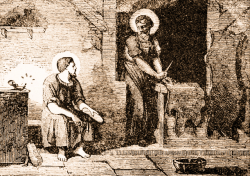Lives of the Saints
Our Models and Protectors
Spiritual Bouquet:
October 25

Saints Crispin
and Crispinian
Martyrs
(†285 or 286)
These two glorious martyrs, who were brothers, were born of a distinguished Roman family; they came from Rome to preach the Faith in Gaul toward the middle of the third century, and took up residence in Soissons. They instructed many in the Faith of Christ, which they preached publicly during the day. At night they worked at making shoes, following the example of Saint Paul who recommends that the preachers of Christ imitate him — that is, sustain themselves when necessary by the work of their own hands. The infidels who came to their workshop were charmed by their polite and affable manners, and enjoyed coming to ask their services and converse with them. The profound conviction which imbued all they said about Christianity made a strong impression on those who heard them. They remained about forty years in this occupation at Soissons without being troubled, even though they determined many to renounce the cult of false gods.
But the time was coming when they were destined to give the most perfect testimony possible to their faith, by suffering many and varied tortures and shedding their blood. In 285 the emperor Diocletian sent his vicar Maximian Herculeus into Gaul, where this tyrant revealed his intentions by ordering the massacre of the entire Theban legion. At Soissons, he soon discovered that the progress of the religion of the Nazarene was largely the effect of the presence there of the two brothers. When summoned to appear before him, they were not moved by either threats or promises; and Maximian, seeing he could do nothing with them, sent them to his minister Rictiovarus, prefect of Gaul, with orders to spare them no sort of torture. At Soissons the memory of their torment is still much alive; an abbey was built at the site of the prison where they were enclosed.
They were suspended by pulleys and struck with clubs; they were tormented in their hands and mouth with wires, and strips of flesh were cut off their backs. They ceased not to pray; when certain instruments destined for them turned against their tormenters, they were regarded as magicians. They were attached to millstones and thrown in the river, but the stones detached themselves, and they swam to the far shore. A hotbed of fire, molten lead and tar did not consume them, and they sang hymns to the Lord. A drop of this mixture seemed to leap from the fire into the eye of Rictiovarus. Out of his mind with fury, he threw himself onto the brazier and there met his end. The martyrs were patient and constant under these fearful torments and finished their course by the sword in the year 286. A Christian brother and sister buried their bodies on their own terrain, where later a public oratory was constructed. On its site, the parish priest of Mattaincourt, Saint Peter Fourier, long afterwards established the Congregation of teaching Sisters which he founded.
Reflection: Of many it can be said that they labor in vain, since God is not the end and purpose that inspires their labor. What will remain of it in the end? But the wonderful insuccess of the martyrs serves directly to make His glory shine with eternal brilliance.
Les Petits Bollandistes: Vies des Saints, by Msgr. Paul Guérin (Bloud et Barral: Paris, 1882), Vol. 12